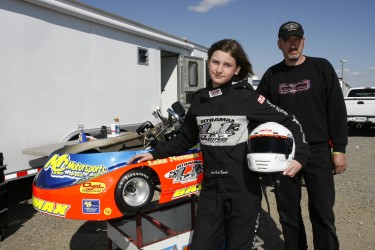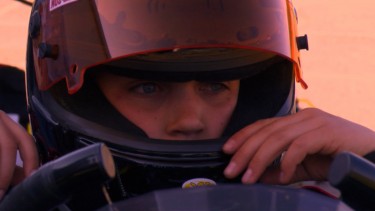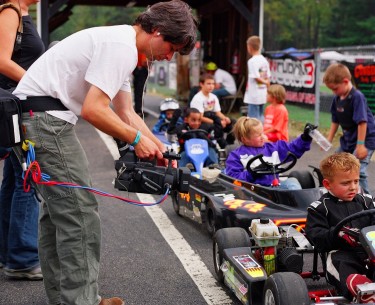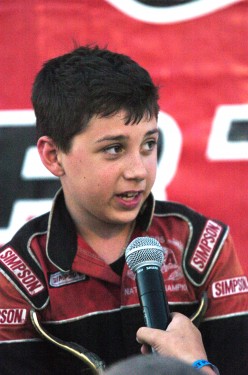 Back to selection
Back to selection
Director Marshall Curry on Racing Dreams
 Brandon Warren (13 years old)
Brandon Warren (13 years old) Ask a filmmaker how to go about making your first film, and 99% of them will impart the easier-said-than-done advice, “Just go and make it.” The technology is there, filming and editing equipment have never been more affordable, and the internet has broken down the barriers between filmmakers and distributors. Few of those filmmakers, however, can give that advice as genuinely as Marshall Curry, who did just that with remarkable results.
While working at a New York multimedia design firm, Curry decided to pursue a latent desire to make documentary films. With no prior experience in filmmaking, he bought a Sony PD150 and started filming Newark’s 2002 mayoral race between Corey Booker and then-four-time incumbent Sharpe James. That film became Street Fight, and was nominated for an Oscar in 2005. Fast forward to today, where Curry has received his second Oscar nomination for his latest film, If A Tree Falls: A Story of the Earth Liberation Front, and you could do a lot worse for a self-taught filmmaker with just three films under his belt.
Between Curry’s first and his latest film falls Racing Dreams, which has its television premiere on PBS on February 23rd at 9PM. Just because it lacks an Oscar nomination doesn’t mean it’s a film to be slighted. Like its oft-cited comparison Hoop Dreams, Racing Dreams locates a multi-character, coming of age story within a sport where the players literally grow up before your eyes. The film was crafted from around 500 hours of footage, and, different from Hoop Dreams, unfolds over a brisk hour and a half.
Racing Dreams explores the so-called “Little League” of NASCAR racing, the World Karting Association, where pre-teens from around the country race go karts at speeds of up to 70 mph. Curry zeroes in on three young drivers — Annabeth (11 years old), Josh (12), and Brandon (13) — and watches them compete for the league’s National Championship. Bearing in mind an urban viewer’s possible ignorance to the sport, he sidesteps the generic, competition film approach and treats racing more as an entry into a lesser known aspect of American life. The majority of Racing Dreams takes place in family households, where popular caricatures of people in the South and Midwest are tested by in-depth portraits of real people dealing with real problems.
Filmmaker sat down with Marshall Curry the day after he received news of his Oscar nomination for If A Tree Falls. We discussed the genesis of his career, Racing Dreams, upcoming projects and independent filmmaking.
Filmmaker: I read in your Director’s Statement that you had no prior interest in racing going into this project. Rather, you were interested in the sport’s potential to offer a window into American culture that coastal elites don’t often consider. Can you talk about the genesis of the project?
Curry: I live in New York, and like most New Yorkers I didn’t know much about NASCAR at all. But I knew that it’s the second biggest spectator sport in America. And my wife is from Charlotte, North Carolina. Both of my parents are from South Carolina, and I have a bunch of family there. So I knew that that attitude was not shared by the rest of the nation. So that just interested me. I thought, “There’s a huge part of this country’s culture that I don’t know very much about.” And that was sort of the seed. I wrote down “NASCAR” on a card and stuck it in a file of ideas that I keep. Then one day I was reading an article about this unofficial little league for NASCAR, where 11-12-13 year-old kids race go-karts that go 70 mph. That seemed amazing. So I went to a few races, and it was amazing. The kids were amazing, the racing was amazing. And it also was a way of getting at adolescence, which is something I think is incredibly important and compelling. Those years of 11, 12 and 13 are so formative and so pivotal, and they get overlooked, I think, by people in general who either want to focus on cute, little, teeny kids or teenagers. But that point of transition is really interesting to me. And it’s great from a documentary filmmaker’s perspective because these kids are articulate enough to have actually interesting things to say, but they’re not guarded and jaded yet.
Filmmaker: So your interests were two-fold: you wanted to portray a sport’s place in American culture and you wanted to portray adolescence. How did you balance those two interests in both your filming and your editing processes?
Curry: I think a lot of it is just following what interests me at any moment. There are a limitless number of things that you could shoot. There are people you can point the camera at or not point the camera at. There are moments when you could be shooting or not shooting. When you’re editing it’s the same thing. I mean, there are hundreds of hours of footage…
Filmmaker: I understand you crafted this film from 500 hours of footage?
Curry: We shot 500 hours of footage. (Pointing to a hard drive) This is a huge RAID of around 14 terabytes…
Filmmaker: I thought that was a refrigerator.
Curry: That’s where all the footage was stored. We had to have a cooling system that constantly ran on it, because at that point we had three people who were editing off of all that footage. But all of those decisions ultimately come down to: “Do I care about this?” It’s a lot more about being honest and listening to your gut. The racing was interesting as long as it was interesting. And the kids were interesting as long as they were interesting.
Filmmaker: How did you go from the racing track to these kids’ homes?
Curry: I knew from the beginning that it was not going to be another classic kid competition film. I felt that Spellbound and Mad Hot Ballroom had done it perfectly. It just didn’t need to be done again. I really wanted it to be more of an in-depth story about just a couple of people, where the competition itself provides the bones of the movie, the arc, framework, but isn’t really the point of the movie at all. So I was looking for people in the beginning who would have something interesting in their home life. And I told all the families from the beginning: “This is going to be about your racing, but it’s also going to be about school and family and being a kid and figuring out your way in the world.”
Filmmaker: How did you discover your subjects?
Curry: The first person I met was Josh. I actually found him at the first race I went to when I was first exploring the idea. And he is just so articulate, and he’s funny, and he’s an amazing racer. He’s like an adult in a child’s body. (Laughs) So I thought, “Well this is great. If I can find another couple kids like this, I’m done!” So based on that, I was able to raise the money to make the movie. And once we had a budget, we went to the awards ceremony from the previous year, which is right next door to the big annual karting convention in North Carolina to find the other kids…The opening scene of Annabeth, where she’s signing autographs and says, “I told my daddy when I was little, ‘I wanna be the first girl to win the Daytona 500′”, that was actually the test footage that we were shooting of her when we were looking for kids. So we met 75 kids probably. And we’d say, “What does your room look like? What do you want to do when you grow up? Do you believe in God?” Any kind of question to draw out who they were and how they talked and how they thought. That footage was literally the first conversation I ever had with her.
Filmmaker: And Brandon?
Curry: We found Brandon that same night. And once we found those three—there were other kids I liked as well—but once we found those three I said, “I think this will be it.”
Filmmaker: All of the kids are wonderfully distinct from one another in terms of their class, their family lives, their temperaments. Were you looking for different character types in your “casting” process?
Curry: Yeah. My first pitch to the financiers was: here are a number of different types of kids that we might look for. I thought, “Maybe it would be interesting to find an African American racer. Maybe it would be fun to find a super rich racer, or a racer who doesn’t have any money.” All these different types. But once I found those three, I realized that those three stories would carry it.
Filmmaker: Trust is central to all documentary filmmaking, but I imagine it was especially important to this film, which primarily takes place in family households. How did you gain such intimate access to your characters’ lives?
Curry: From the very beginning, I explained to people that I wanted to make the film about their lives. But there’s a big difference between explaining that to somebody and actually being there with a camera when something emotional and traumatic is happening. I spent a lot of time with them. We shot at their houses a lot. We shot at the track a lot. They became used to having us around, and we created a real relationship. I also shoot with a very small footprint. It’s usually two people—either I’m shooting and I have a sound person, or I’m doing sound with a shooter. We don’t set up lights. We don’t have a large boom pole that is sticking into people’s faces. When I can put a wireless lavalier on people and just let them forget about it, that’s ideal. Our cameras are small. We shot it with an HVX200. So it’s a nice HD image, but it’s not a giant shoulder-mounted camera. And all of that, I think, is a part of getting trust. Also, I just honestly really liked these people. And I think they could sense that.
Filmmaker: Was it hard for you, then, to edit scenes where they come off in a negative light? I’m mainly referring to Brandon’s situation, which sort of takes center stage in the film—his father’s criminality, his non-existent mother…
Curry: As we sat down to edit, it [became] difficult because it’s one thing to share something with somebody who’s in your house and who you’ve gotten to know over a year together, and it’s another thing to share it on national television or with a theater full of people. And I wanted to make sure that they understood what was going to happen. It was important to me to tell an accurate story, not to airbrush away the warts. But also not to smear or exploit people, and to contextualize those difficult experiences for audiences, so that it elicits empathy and makes people feel a connection with the characters. The truth is that everybody probably has a relative who has a drug problem or a mental health problem or something like that, or some other problem that they don’t really want the public to know about. And everybody has financial worries. And everybody has been on that phone call between Annabeth and Brandon when they’re acting so goofy and awesome at the same time, flirting. (Laughs) As we were shooting that scene, I said, “Oh my God. I’ve been on this phone call!” So when you can make that connection, I think it creates a nice bond with the audience.
Filmmaker: How have your subjects responded to the film?

Curry: Once we finished the cut, I traveled around to each family and showed it to them to make sure that they were comfortable with it. And all of them said that they were. When I showed it to Brandon’s family—that was the one I was most nervous about—his grandmother was crying and said, “It’s hard to watch, but it’s true. And I wouldn’t change a thing. And I hope that by sharing our story with other people, something good can come of it.”
Filmmaker: As an East Coaster, were there any hurdles you had to overcome in ingratiating yourself with people in the South and the Midwest?
Curry: I’d say I’m sort of bilingual, because both of my parents are from South Carolina. My wife is from Charlotte, North Carolina. And I lived in North Carolina myself from 4th to 8th grade. But most of my life I’ve lived in New Jersey and New York. So one of the goals of the film honestly was to try to educate the filmmaking/documentary set about who the people are that they only see caricatured in movies and on TV. I feel like a lot of times the media sees people like the characters in the film as either uneducated rednecks or as the other extreme: perfect, farmer, salt-of-the-earth [types]. And in fact, they’re people just like everybody else. They’re complex, they’re smart, they’re sensitive, they’re raising their kids and pursuing their dreams. So that’s what I was really trying to capture.
Filmmaker: This film falls in between Street Fight and If a Tree Falls, which are both political in their orientations. Racing Dreams depicts a sport that is much more hedonistic. How would you contextualize the film within your body of work?
Curry: Somebody said to me a little while ago that, “These three films are sort of the ‘American Trilogy’. Everything you need to know about America you can learn through inner-city politics, NASCAR, and radical environmentalism.” (Laughs) It kind of sums up our country. Ideally, my goal was that all of the films would be about personal struggle more than a particular issue. So Street Fight is sort of about inner-city politics in Newark—who’s the mayor of Newark?—but most people don’t know or care who the mayor of Newark is. So the movie couldn’t ultimately be about that. It had to be something more. When I was editing it, there were scenes where they would argue about zoning regulations, and other local issues, and I realized, “That’s not the heart of this movie. The heart of this movie is a young idealist taking on a political titan and finding that it’s not as easy as he hoped.” And that story plays out on the national level. It plays out in South Carolina. It plays out in Newark. I get emails from people in Mexico and other countries saying, “This is just like the elections in Israel,” or “This is just like the elections in my area.” And If a Tree Falls is sort of about the environmental movement, but it’s also about what happens when people feel they don’t have a voice. There’s a lot of thematic overlap between the environmental movement of the ’90s and the Occupy movement of today. What kind of tactics should we employ? How should the government respond to activism? And also, it’s a personal story—a coming of age tale—about discovering what’s important to you, and deciding to get involved in things that maybe get out of control. It could be arson or it could be a hundred other things that would have fit into that same story.
Filmmaker: I think Racing Dreams is your most impressive film, stylistically, because of the action at its center and the visceral way in which it is shot. That must have been a learning experience for you, no?Curry: I feel like technically it’s probably my strongest film. Street Fight was just me with a little PD150 and microphones in my pockets and clipboards with releases and driving the car around and doing all that production work myself. So that one was pretty run-and-gun and pretty raw. For If a Tree Falls, we didn’t really have money. A lot of it is made of stitched-together archival material from activists that were shooting on VHS tapes or Hi-8 in the ’80s and ’90s. So it also doesn’t have a super polished look. Racing Dreams was the first one that actually had a budget from the beginning, and we were able to use good equipment and have the manpower to do things the way that I wanted to do them.
Filmmaker: What sort of preparations did you make before filming the racing sequences?

Curry: We sat down and spent a lot of time before the first race trying to figure out how to do it. We would have one camera that was a big HD camera with a very long lens on it that would shoot the establishing shot of the race. That would constantly go in on our character, in and out, and just track the whole race from an elevated position, either on top of an RV or on the bleachers or something like that. And then we would put three smaller cameras at three different turns, and they would just get those detail moments of people coming around a turn, or making a pass. A lot of times one of the detail people would also shoot reactions from the crowd. So when we sat down to edit, we would have four video tracks of all of the races. You always knew that you could lean on your establishing image, but a lot of the poppy-er detail shots you could cut in too.
Filmmaker: So here you are in an office with a refrigerator-sized hard drive and numerous monitors around. You’re a two-time Oscar nominated filmmaker…
Curry: (Laughs) How does that happen?
Filmmaker: How does it feel?
Curry: It feels pretty weird. It’s been really hard. The work is really, really hard. All three of my films were much more difficult than I could have possibly imagined. If you asked me when we started making If a Tree Falls how long it would take, I would have said, “We’ll shoot until Daniel [McGowan] goes to prison, which will be in maybe a year. We’ll have a couple months of interviews, nine months of editing, we’ll be done in two years.” Fast-forward five years to finish the movie. And it was a really hard edit. And it was really hard to get the access. And really hard to raise the money. Making documentaries is hard work. But I love it. I love shooting and I love editing, and I love having a license to go into people’s lives and ask them personal questions and explore worlds that I don’t know anything about. If I could find somebody to take over all of the business side, that would be the ideal. But I haven’t found that yet.
Filmmaker: Your advice to first-time documentary filmmakers?
Curry: It’s a great time to make documentary films. Never in history has it been as easy as it is now to make a documentary film, technically and financially. You can buy a camera for very little money that can shoot a beautiful image. You can edit with nonlinear systems that twenty years ago you literally would have had to take out a mortgage to buy. Those Avid systems did what you can do today on Final Cut Pro, with a couple of hard drives that you buy at Staples. And it’s unbelievable. So the barrier to doing it is lower than it’s ever been, and that should inspire people who are interested in sticking their foot in. Just get in. Don’t spend too much time trying to raise the money, trying to make everything perfect. Just get in and start making stuff. That’s my advice, and that’s what I love.
Filmmaker: So what are you working on next?
Curry: It’s a documentary about Lennox Lewis, the former Heavyweight boxing champion. He retired about six years ago, and now he’s 47, retired as the undisputed heavyweight champion of the world, and now he’s trying to figure out what to do with the rest of his life. He’s in this funny position of having worked his whole life to achieve something, achieved it, and now he’s got forty more years ahead of him—what’s he going to do with it? So it’s partly that question, and partly a look back at his career and how he got to the place that he is.


